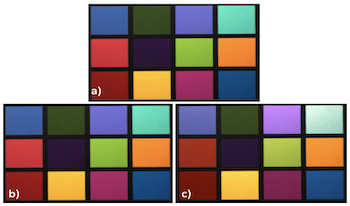
Colour correction is the process of converting camera dependent RGB values to a camera independent standard colour space such as CIE XYZ. Regression methods — linear, polynomial, and root-polynomial least-squares — are traditionally used to solve for the colour correction transform. More recently neural net solutions for colour correction have been developed. This paper begins with the observation that the neural net solution — while delivering better colour correction accuracy compared to the simple (and widely deployed) 3×3 linear correction matrix approach — is not exposure invariant. That is to say, the network is tuned to mapping RGBs to XYZs for a fixed exposure level and when this exposure level changes, its performance degrades (and it delivers less accurate colour correction compared to the 3x3 matrix approach which is exposure invariant). We develop two remedies to the exposure variation problem. First, we augment the data we use to train the network to include responses for many different exposures. Concomitantly, the trained network is robust to a changing exposure. Second, we redesign the network so, by construction, it is exposure invariant. Experiments demonstrate that, by adopting either approach, Neural Network colour correction can be made exposure invariant.
Abdullah Kucuk, Graham D. Finlayson, Rafal Mantiuk, Maliha Ashraf, "An Exposure Invariant Neural Network for Colour Correction" in Color and Imaging Conference, 2022, pp 176 - 181, https://doi.org/10.2352/CIC.2022.30.1.31
 Find this author on Google Scholar
Find this author on Google Scholar Find this author on PubMed
Find this author on PubMed